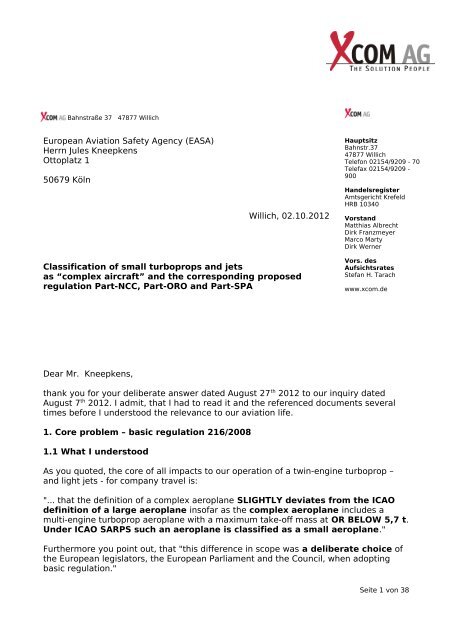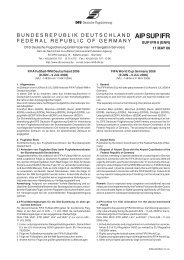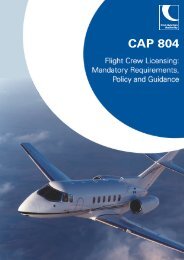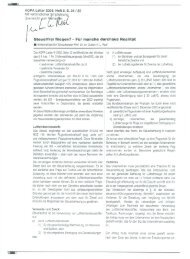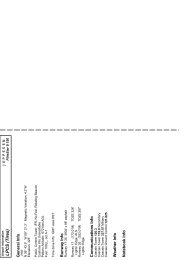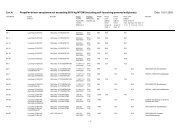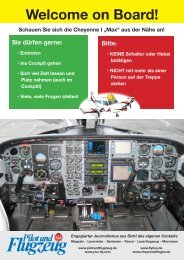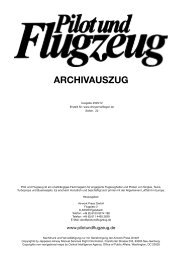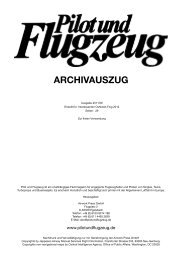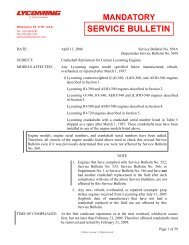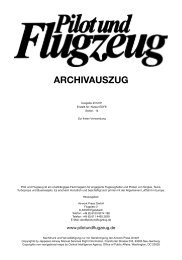Dear Mr. Kneepkens, thank you for your deliberate answer dated ...
Dear Mr. Kneepkens, thank you for your deliberate answer dated ...
Dear Mr. Kneepkens, thank you for your deliberate answer dated ...
You also want an ePaper? Increase the reach of your titles
YUMPU automatically turns print PDFs into web optimized ePapers that Google loves.
Bahnstraße 37 47877 Willich<br />
European Aviation Safety Agency (EASA)<br />
Herrn Jules <strong>Kneepkens</strong><br />
Ottoplatz 1<br />
50679 Köln<br />
Willich, 02.10.2012<br />
Hauptsitz<br />
Bahnstr.37<br />
47877 Willich<br />
Telefon 02154/9209 - 70<br />
Telefax 02154/9209 -<br />
900<br />
Handelsregister<br />
Amtsgericht Krefeld<br />
HRB 10340<br />
Vorstand<br />
Matthias Albrecht<br />
Dirk Franzmeyer<br />
Marco Marty<br />
Dirk Werner<br />
Classification of small turboprops and jets<br />
as “complex aircraft” and the corresponding proposed<br />
regulation Part-NCC, Part-ORO and Part-SPA<br />
Vors. des<br />
Aufsichtsrates<br />
Stefan H. Tarach<br />
www.xcom.de<br />
<strong>Dear</strong> <strong>Mr</strong>. <strong>Kneepkens</strong>,<br />
<strong>thank</strong> <strong>you</strong> <strong>for</strong> <strong>you</strong>r <strong>deliberate</strong> <strong>answer</strong> <strong>dated</strong> August 27 th 2012 to our inquiry <strong>dated</strong><br />
August 7 th 2012. I admit, that I had to read it and the referenced documents several<br />
times be<strong>for</strong>e I understood the relevance to our aviation life.<br />
1. Core problem – basic regulation 216/2008<br />
1.1 What I understood<br />
As <strong>you</strong> quoted, the core of all impacts to our operation of a twin-engine turboprop –<br />
and light jets - <strong>for</strong> company travel is:<br />
"... that the definition of a complex aeroplane SLIGHTLY deviates from the ICAO<br />
definition of a large aeroplane insofar as the complex aeroplane includes a<br />
multi-engine turboprop aeroplane with a maximum take-off mass at OR BELOW 5,7 t.<br />
Under ICAO SARPS such an aeroplane is classified as a small aeroplane."<br />
Furthermore <strong>you</strong> point out, that "this difference in scope was a <strong>deliberate</strong> choice of<br />
the European legislators, the European Parliament and the Council, when adopting<br />
basic regulation."<br />
Seite 1 von 38
1.2 Request <strong>for</strong> clarification<br />
I have to admit that these fine differences are out of scope of the comprehension of<br />
the ordinary non-flying citizen – and probably legislator. Could <strong>you</strong> please lay out<br />
<strong>for</strong> me how this rule making process was governed and by whom to come to<br />
this conclusion? I assume that EASA (or its predecessor) was consulted and was a<br />
part of that rule making.<br />
We understand that all rule making impacting turboprops and small jets below 5,7<br />
tons (max take-off mass) such as Part-NCC, Part-ORO and Part-SPA is only a<br />
consequence of this initial decision and would not be relevant, if the European Union<br />
would apply the standard ICAO classification which has served well <strong>for</strong> many years.<br />
We understand that the rule making makes sense <strong>for</strong> large aircraft – and severely<br />
doubt that it will help to increase any safety <strong>for</strong> small aircraft. It will actually drive<br />
users from more safe twin engine (either turboprop or jet) to less safe single-engine<br />
aircraft to avoid this regulation. And it will hurt the European economy and airport<br />
infrastructure.<br />
To visualize which kinds of aircraft are now proposed to be regulated under the same<br />
set of rules, here a picture of a “big” turboprop under 5,7 tons, a Piaggio Avanti P180<br />
with 5,2 tons, next to a middle-sized commercial airliner, a Boeing 757:<br />
Seite 2 von 38
Independently of the clarification requested regarding the genesis of the<br />
Basic Regulation and accepting it the way it is, could <strong>you</strong> please explain how<br />
the Basic Regulation constitutes a necessity to regulate non-commercial<br />
operation of complex aeroplanes any more than in the past?<br />
1.3 Request <strong>for</strong> change<br />
Please consider to propose to the European legislators to change the basic regulation<br />
to go back to the ICAO SARPS definition and call twin engine turboprops and small jets<br />
"complex aircraft" above a max take-off mass of 5,7 tons. What can we do to promote<br />
this proposal? To whom do we have to talk to? Can EASA make this proposal to the<br />
legislator by itself?<br />
2. Impact Study as a basis <strong>for</strong> Part-NCC et al.<br />
2.1 What I understood<br />
In <strong>you</strong>r <strong>answer</strong> <strong>you</strong> wrote:<br />
“Finally, I would like to comment to some of <strong>you</strong>r econonomic argumements against<br />
the application of NCC.POL.125. Let me assure <strong>you</strong> that the Agency takes economic<br />
consideration duly into account when developing its safety rules. However, economic<br />
considerations have to be assessed against any undue negative impact on safety. It<br />
would not be acceptable to compromise safety solely on the fact that some<br />
aerodrome operators with shorter runways are in financial difficulties. Nor can the<br />
Agency accept to rewrite safety rules to accommodate specific individual cases.”<br />
Let me assure <strong>you</strong> that safety of operation is a major concern <strong>for</strong> corporate air travel.<br />
After all, the company is transporting its most valuable good – the value producing<br />
employee. And that is the reason why we invested and invest heavily into suitable<br />
aircraft and training of the pilots.<br />
2.2 Request <strong>for</strong> clarification<br />
Your <strong>answer</strong> triggered our wish to understand how he Agency “takes economic<br />
consideration duly into account when developing its safety rules”. The only<br />
consideration available to me is a document labled NPA 2009-02g and named<br />
“Implementing Rules <strong>for</strong> Air Operations of Community Operators”<br />
G. Regulatory Impact Assessment <strong>for</strong> the Supplementing Measures <strong>for</strong> Air<br />
Operations(per Article 8(5) of Regulation (EC) No 216/2008)<br />
Seite 3 von 38
Reading this document brings up three distinct questions relevant to Part-NCC, Part-<br />
ORO and Part-SPA:<br />
• Are there any safety problems which make more regulation of corporate and<br />
owner-operated operations of aeroplanes necessary?<br />
• Independent of that <strong>answer</strong>, have all economical impacts been “duly taken into<br />
account”?<br />
• Since that “Regulatory Impact Assessment” was made in 2009 and there<strong>for</strong>e<br />
well ahead in time of the proposed Part-NCC, Part-ORO and Part-SPA, there us<br />
surely a new “Regulatory Impact Assessment” covering all economical impacts<br />
of the proposed regulations. Could <strong>you</strong> please supply me with an<br />
electronic copy of that newer “Regulatory Impact Assessment”?<br />
2.2.1 Are there any safety problems which make more regulation of<br />
corporate and owner-operated operations of aeroplanes necessary?<br />
NPA 2009-02g describes the methodology, how the study is done, then goes over the<br />
safety levels in Europe and then discusses the impact of different levels of regulation<br />
<strong>for</strong> the various branches which use aircraft. Using <strong>you</strong>r terminology, three branches of<br />
aircraft-use relate to our problem:<br />
• Air Taxi – commercial operators using complex aircraft below and above 5,7<br />
tons MTOM to transport people or goods – already under the strict<br />
regulation of national Air Operator Certificates (“AOC”) - which are the<br />
blueprint <strong>for</strong> the proposed Part-NCC and Part-ORO regulation<br />
• Corporate – private operators using complex aircraft below and above 5,7 tons<br />
MTOM to transport people or goods – currently under no regulation comparable<br />
to AOCs<br />
• Owner-operated: using complex aircraft below and above 5,7 tons MTOM to<br />
transport people or goods – currently under no regulation comparable to AOCs<br />
Please let me quote from <strong>you</strong>r document:<br />
“According to the EUROCONTROL report on “Business Aviation in Europe in 2007”36,<br />
about 764,000 IFR flights have been carried out in Europe in 2007 by business<br />
aviation. Assuming 800,000 flights/year and using the data in table 9 above, the<br />
following figures are estimated: ”<br />
Seite 4 von 38
Let me direct <strong>you</strong>r attention to the line which states “Accident rate (per 100,000<br />
hours):<br />
• Air Taxi (currently strictly regulated): 2.08<br />
• Corporte (currently not regulated that strictly): 0.15<br />
• Owner operated (currently not regulated that strictly): 1.7<br />
These numbers show that the strict regulations <strong>for</strong> Air Taxi operators lead to a<br />
significantly higher accident rate than <strong>for</strong> the currently less-strictly regulated<br />
Corporate and Owner-operated aircraft use of complex aeroplanes. The accident<br />
rate of Air Taxi operators is 22 % higher than that of the Owner-operated<br />
aeroplanes and almost 14 times (!) higher than that of Corporate aeroplane<br />
use.<br />
One would probably be cynical to propose to drop the strict regulations <strong>for</strong> Air Taxi<br />
operators to improve their safety record. But certainly questions should be raised –<br />
especially by EASA.<br />
In <strong>you</strong>r document <strong>you</strong> have discussed three options how to potentially regulated noncommercial<br />
operations by complex motor-powered aircraft:<br />
• 3A: all organisations managing one or more complex motor-powered aircraft<br />
shall hold an Air Operator Certificate (AOC), based on the same process<br />
applicable to commercial operations<br />
• 3B: all organisations managing one or more complex motor-powered aircraft<br />
shall be certified, however based on rules proportionate to the size and<br />
per<strong>for</strong>mance of the aircraft, as well as the volume and complexity of operations;<br />
Seite 5 von 38
• 3C: Declaration signed by the natural or legal person managing the aircraft and<br />
endorsed by the owner(s), based on proportionate rules.<br />
In the course of evaluating the different options, <strong>you</strong> heavily discuss the need to<br />
regulate “fractional ownerships” which are now neither clearly commercial or private.<br />
This perspective seems – and the wish to regulate more heavily - to influence the rest<br />
of the discussion. Let me again quote <strong>you</strong>r document, since it already <strong>answer</strong>s the<br />
question I raised:<br />
In case of options 3A and 3B, the owner will be assured by the AOC process that the<br />
operator possesses sufficient organisation and competence. However, also in case of<br />
option 3C this confidence will be reached since the proposed declaration, which has<br />
legal value, contains all the elements (including the name of the accountable manager<br />
or responsible natural person) necessary to demonstrate that the organisation<br />
managing the operations on behalf of the owners is taking operational control.<br />
Furthermore, non-commercial operations of complex motor-powered aircraft are not<br />
driven by competitive pressures and the operational safety standards are to a<br />
significant degree under the control of the owners, which unavoidably take<br />
care <strong>for</strong> themselves and their invited passengers. In this case then the<br />
power (ownership) and interest (himself/herself is a passenger) of the owner<br />
can be a powerful tool to maintain sufficient levels of safety, even in the<br />
presence of the declaration instead of the certificate.<br />
Well, as <strong>you</strong> describe here, caring <strong>for</strong> <strong>you</strong>r own life and that of <strong>you</strong>r valued passengers<br />
makes a better safety incentive than heavy regulation – and it clearly shows in the<br />
numbers. From there the argument of the Agency continues:<br />
In fact, the data summarised in paragraph 2.3.2.5 on the safety of business<br />
aviation clearly shows that the rate of yearly accidents in the EASA 27 + 4<br />
<strong>for</strong> air taxi (i.e. 5/year), corporate (i.e. 0.7/year) and owner-operated<br />
business aviation (i.e. 1.9/year) are lower than the rate <strong>for</strong> commercial air<br />
transport by large aeroplanes (i.e. 20.5).<br />
This safety record <strong>for</strong> corporate operations is at least equivalent to large scheduled<br />
airline operations and demonstrates the industry’s long term voluntary application of<br />
good safety practices. Given this safety record, there is no evidence that a<br />
more stringent certification scheme, in addition to the good practices<br />
already applied by the industry itself through its codes of practice, will lead<br />
to a substantial increase of the safety levels.<br />
Well, I have to say it flatters me to have confirmed by <strong>you</strong>r Agency that we (corporate<br />
and owner-operated operators) have a better safety record than commercial air<br />
transport by large aeroplanes. I think this is worth pointing out to the public media<br />
since the common perception is certainly different. But what is really remarkable is,<br />
that <strong>you</strong> concede that “there is no evidence a more stringent certification<br />
scheme … will lead to a substantial increase of the safety levels.” It could not<br />
have been said any better.<br />
Seite 6 von 38
And let us not go into the question why all the regulations do not produce a better<br />
safety record <strong>for</strong> commercial air transport by large aeroplanes and which responsibility<br />
EASA has <strong>for</strong> this.<br />
Looking at <strong>you</strong>r document, would <strong>you</strong> please explain how <strong>you</strong> come to the<br />
conclusion in <strong>you</strong>r letter that there is a safety issue which might be<br />
improved by stricter regulation and that we are proposing to endanger<br />
safety by requesting to not applay Part-NCC to aircraft below 5,7 tons – as<br />
the rest of the ICAO world does it?<br />
2.2.2 Have all economical impacts been “duly taken into account”?<br />
NPA 2009-02g does consider the economic impact. The following categories are<br />
discussed:<br />
• Rulemaking and standardisation costs<br />
• Oversight costs<br />
• Regulatory costs <strong>for</strong> the operators<br />
• Additional demand (e. g. <strong>for</strong> consultants under option 3B)<br />
Very clearly, the impact on airport operators have not been taken into<br />
account in this study. Unless there is another impact study – which we assume –<br />
this impacts has not been taken into account. Besides the economical impact on<br />
airport operators there is certainly an economical impart on the usability of<br />
light jets <strong>for</strong> the operators once they are not able to use small airports any<br />
more. Let me repeat: we do not propose to jeopardize safety. The current regulations<br />
allow the use of small airports and <strong>you</strong>r agency has confirmed “that there is no<br />
evidence … that a stricter regulation will lead to a substantial increase of the safety<br />
levels”.<br />
So I have to sum up that not all economical impacts have been duly taken into<br />
account in NAP 2009-02g and it thus is not a sufficient basis <strong>for</strong> Part-NCC, Part-ORO<br />
and Part-SPA.<br />
But be<strong>for</strong>e we continue, we would like to comment on the economical impact on the<br />
operator which is evaluated at EUR 90k per year <strong>for</strong> the small corporate and owneroperated<br />
owner in 2007 number (which are now certainly higher). (“Cost of labour<br />
inside this organisation is assumed to be in the range of 60 k€ (2009)/year. Cost of<br />
consultants is assumed to be 90 k€ (2007)/year. ”) We would like to elaborate on two<br />
perspectives:<br />
• To which percentage is the use of small aircraft increase by this costs?<br />
• What do we estimate as future costs <strong>for</strong> operators?<br />
For the interested non-flying reader, we have given picture examples of typical aircraft<br />
below 5,7 tons in the appendix. Since our argument related to the impact of <strong>you</strong>r<br />
regulation on operating cost, we first want to give the interested reader an estimate<br />
Seite 7 von 38
<strong>for</strong> all-in operation costs (depreciation, maintenance, insurance, hangar, fuel, airway<br />
fees, etc.). Without the cost <strong>for</strong> a pilot per flight hour we estimate:<br />
Aircraft Type<br />
Operation cost all in per flight hour<br />
Single-engine piston EUR 150 to EUR 300<br />
Multi-engine piston EUR 400 to EUR 800<br />
Single-engine turboprop < 5,7 to EUR 1.000 to EUR 2.000<br />
Multi-engine turboprop < 5,7 to EUR 1.000 to EUR 3.000<br />
Small twin-engine jet < 5,7 to EUR 1.800 to EUR 3.000<br />
Bigger twin-engine jet > 5,7 to<br />
EUR 3.000 to “unlimited”<br />
Part-ORO will require the operator in the future (once it has passed legislation)<br />
amongst other things to:<br />
• significant runway length <strong>for</strong> all aircraft with a V1 specified in the manual, which<br />
is probably the case <strong>for</strong> all jets and no turboprops, but which will rule 90 % of all<br />
German airfields out <strong>for</strong> these small jets (see NCC.POL.125 (b))<br />
• develop an operations manual (ORO.GEN.110)<br />
• apply <strong>for</strong> air operator certificate and get it granted (ORO.GEN.115)<br />
• develop and maintain a management system (incl. safety management system)<br />
(ORO.GEN.200)<br />
• record keeping (ORO.GEN.220)<br />
• regular auditing (ORO.GEN.135)<br />
In contrast to NPA 2009-02g we estimate that <strong>for</strong> the operation of a single aircraft <strong>for</strong><br />
personal use or company travel this will require additional 2 employees. At total cost<br />
of EUR 100.000 per employee this will increase the cost of operating a small twinengine<br />
turboprop or jet by EUR 200.000 per year. So in the past a small turboprop was<br />
operated <strong>for</strong> e. g. 200 hours * EUR 1.000 per hour = EUR 200.000 per year. Your<br />
additional requirements thus double the cost of operating that aircraft.<br />
Now let us look at the safety benefits: Your regulations still allow to fly these aircraft<br />
with one appropriately trained and rated pilot (see ORO.FC.100). This pilot has been<br />
licensed under JAR FCL rules – and thus this pilot is competent to safely<br />
operate the aircraft. Since he or she is already competent to safely operate<br />
the aircraft, he or she will not gain any additional safety from <strong>you</strong>r new<br />
regulations.<br />
In our example we are looking at a safety-aware pilot flying either <strong>for</strong> personal use or<br />
<strong>for</strong> company travel, he or she has already invested into a twin-engine turboprop. Your<br />
new regulations now either <strong>for</strong>ce this operator to tolerate twice the cost he<br />
or she previously incurred without gaining any additional safety or the<br />
operator will go to a less safe “non-complex” aircraft such as a single-engine<br />
turboprop.<br />
Seite 8 von 38
Independent of the impact on operators there is certainly an infacstructural impact<br />
which has not been covered by NPA 2009-02g. We would like to point out which<br />
consequences this will have in Germany and assume that similar effects will applay in<br />
the other 26+4 countries. We will leave it to e. g. IAOPA to show the effects on<br />
complete Europe.<br />
Besides the impact on operation costs <strong>for</strong> turboprops there is the impact on future<br />
runway length necessary to operate small jets in accordance with NCC.POL.125 (b).<br />
We have identified a runway length of 1.400 m to operate a small jet at max take-off<br />
weight at 30 degrees Celsius as being a reasonable assumption. Out of 398 airfields in<br />
Germany, 26 have a runway length longer than 1.400 m. See the list of airfields as<br />
appendix 3. But <strong>you</strong> will notice that the airfields are either major international airports<br />
– not having the capacity to cope with additional jet traffic – or <strong>for</strong>mer military bases in<br />
the <strong>for</strong>mer Eastern Germany. Thus German companies will have problems operating<br />
jets to German airfields – and international visitors will have problems finding an<br />
appropriate airfield next to their destination. We did not check other European<br />
countries but assume that the consequences will be comparable.<br />
Here is that map of available airports (besides the international airports, which in<br />
general do not have an appropriate capacity <strong>for</strong> General Aviation traffic or the<br />
handling at these airports make them less attractive than smaller airports):<br />
Seite 9 von 38
Since <strong>you</strong> have surely made a study on the impact of <strong>you</strong>r basic rule making of<br />
considering small jets under 5,7 tons as complex aircraft <strong>for</strong> the airfield infrastructure<br />
in Europe, could we please have that study? Could <strong>you</strong> please name all European<br />
airfields with runways greater 1.400 m so that the legislators we will approach can<br />
judge what this will do to their business infrastrure?<br />
As appendices please find pictures of general aviation aircraft below 5,7 tons (except<br />
<strong>for</strong> the “big” jet) and a visual comparision of our company's aircraft to a 757, so that<br />
the non-flying reader understands to which size of aircraft <strong>you</strong> want to apply the same<br />
regulations as <strong>for</strong> a Boeing 747 or an Airbus A380, the text of <strong>you</strong>r proposed<br />
regulation<br />
Seite 10 von 38
2.2.3 Appropriate Impact study <strong>for</strong> Part-NCC, Part-ORO and Part-SPA<br />
Since that “Regulatory Impact Assessment” was made in 2009 and there<strong>for</strong>e well<br />
ahead in time of the proposed Part-NCC, Part-ORO and Part-SPA, there us surely a new<br />
“Regulatory Impact Assessment” covering all missing economical impacts of the<br />
proposed regulations. Could <strong>you</strong> please supply me with an electronic copy of<br />
that newer “Regulatory Impact Assessment”?<br />
2.3 Request <strong>for</strong> change<br />
Since <strong>you</strong>r own “Regulatory Impact Assessment <strong>for</strong> the Supplementing Measures <strong>for</strong><br />
Air Operations(per Article 8(5) of Regulation (EC) No 216/2008) ” (NPA 2009-02g)<br />
states<br />
Given this safety record, there is no evidence that a more stringent<br />
certification scheme, in addition to the good practices already applied by<br />
the industry itself through its codes of practice, will lead to a substantial<br />
increase of the safety levels.<br />
we request that <strong>you</strong> change EASA's position to adopt option 3C of <strong>you</strong>r Assessment,<br />
namely<br />
• 3C: Declaration signed by the natural or legal person managing the aircraft and<br />
endorsed by the owner(s), based on proportionate rules.<br />
This will lead to the same safety level of today - which is much better than commercial<br />
operations – and avoid all the negative impacts.<br />
4. Our petition<br />
If <strong>you</strong> accept that companies use aircraft despite the resulting high cost because<br />
their business models require it, the decision to treat any twin engine turboprop and<br />
small jet as a "large and complex aircraft" and to make it subject to theses regulations<br />
either drives the users to smaller - and inherently less safe - aircraft or significantly<br />
increases the cost of this valuable business tool without any gain in safety. Please<br />
consider to propose to the European legislators to change the basic<br />
regulation to go back to the ICAO SARPS definition and call twin engine<br />
turboprops and small jets "complex aircraft" above a max take-off mass of<br />
5,7 tons.<br />
And please consider to regulate NCC operations with “Declaration signed by<br />
the natural or legal person managing the aircraft and endorsed by the<br />
owner(s), based on proportionate rules. ” to keep non-commercial operators<br />
flying multi-engine aeroplanes and not <strong>for</strong>ce them into single-engine aircraft. And in<br />
the interest of Europe to keep the resulting income <strong>for</strong> all the small airport.<br />
Seite 11 von 38
We understand, that <strong>you</strong>r position regarding Part-NCC has left EASA and has been<br />
submitted to the Commission and is there<strong>for</strong>e out of <strong>you</strong>r hands. Nevertheless we<br />
would kindly ask that <strong>you</strong> reconsider <strong>you</strong>r position and – if possible – modify the<br />
statements sent out to the Commission.<br />
Sincerely <strong>you</strong>rs,<br />
XCOM Aktiengesellschaft<br />
Matthias Albrecht<br />
Seite 12 von 38
Appendix 1: Types of small aircraft and comparision to big aircraft<br />
To visualize the aircraft this discussion is about, we show pictures of the difference<br />
classes of General Aviation aircraft. And we show a comparision between a big small<br />
General Aviation aircraft (Piaggio P180) to an average airliner (neither 747 nor A380).<br />
Comparision of a “big small aircraft” and a “large aircraft”<br />
ICAO classifies aircraft up to 5,7 tons as small. See the following picture of a big small<br />
aircraft (MTOW 5,2 tons) against a large to put things into perspective first. In front,<br />
<strong>you</strong> see a 757 and in the left hand corner find the “big” small aircraft operated by our<br />
company (Piaggio P180). Picture taken in Keflavik when ferrying the aircraft from the<br />
US to Europe. EASA now wants to regulate the small aircraft on the left the same as<br />
the big one.<br />
Seite 13 von 38
Single engine piston aircraft<br />
Ranging from 2 to 6 seats, typically used <strong>for</strong> training and personal flying, such as the<br />
Cessna 172.<br />
If the engine quits on this aircraft, it becomes a glider. These aircraft are rarely used<br />
<strong>for</strong> regular company travel due to missing de-icing capabilities etc.<br />
Seite 14 von 38
Multi (twin) engine piston<br />
Ranging from 4 to 10 seats, typically used <strong>for</strong> personal flying <strong>for</strong> the safety aware pilot<br />
(with more financial means) and entry-level company travel, such as the plane I have<br />
flown <strong>for</strong> more than 500 hours, a Piper Seneca II.<br />
This is the smallest aircraft class which can be used <strong>for</strong> regular company travel from<br />
our perspective.<br />
Seite 15 von 38
Single-engine turboprops<br />
Ranging from 6 to 10 seats, which fly faster and the turbine driving the prop is much<br />
more reliable than the piston engines, used <strong>for</strong> high-end personal flying and company<br />
travel .<br />
If the engine quits on this aircraft, it becomes a glider. It is thus less safe than a twinengine<br />
aircraft which by design can still fly home (or at least to the next airport) on<br />
the remaining engine. Aside from this these aircraft are capable of conducting regular<br />
company travels.<br />
Nevertheless we have operated such an aircraft <strong>for</strong> more than 1.000 hours be<strong>for</strong>e we<br />
upgraded to the twin-engine turboprop.<br />
Seite 16 von 38
Multi-engine turboprops<br />
Ranging from 6 to 19 seats, either small ones used <strong>for</strong> high-end personal flying or or<br />
slightly bigger ones used <strong>for</strong> company travel<br />
or<br />
Seite 17 von 38
This is our company's aircraft which is at the upper end of “small” aircraft below 5,7<br />
tons (Piaggio P180):<br />
These aircraft offer more or less the same flying capabilities as commercial commuter<br />
aircraft.<br />
Seite 18 von 38
Small twin engine jet<br />
Ranging from 6 to 8 seats, either small ones used <strong>for</strong> high-end personal flying or used<br />
<strong>for</strong> company travel<br />
Seite 19 von 38
Bigger "small" twin engine jets<br />
Ranging from 8 to 12 seats, used <strong>for</strong> high-end personal flying or used <strong>for</strong> company<br />
travel (here an aircraft which is heavier than 5,7 tons)<br />
Seite 20 von 38
Appendix 2: Text of proposed rule making from the published proposals – as<br />
quoted in the letter above<br />
NCC.POL.125 Take-off — aeroplanes<br />
(a) When determining the maximum take-off mass, the pilot-in-command shall take<br />
the<br />
following into account:<br />
(1) the calculated take-off distance shall not exceed the take-off distance available<br />
with a clearway distance not exceeding half of the take-off run available;<br />
(2) the calculated take-off run shall not exceed the take-off run available;<br />
(3) a single value of V1 shall be used <strong>for</strong> the rejected and continued take-off, where<br />
a V1 is specified in the AFM; and<br />
(4) on a wet or contaminated runway, the take-off mass shall not exceed that<br />
permitted <strong>for</strong> a take-off on a dry runway under the same conditions.<br />
Annex VI ‘Part-NCC’<br />
Page 34 of 63<br />
(b) In the event of an engine failure during take-off, the pilot-in-command shall ensure<br />
that:<br />
(1) <strong>for</strong> the aeroplane where a V1 is specified in the AFM, the aeroplane shall be able<br />
to discontinue the take-off and stop within the accelerate-stop distance<br />
available; and<br />
(2) <strong>for</strong> the aeroplane where a net take-off flight path is specified in the AFM, the<br />
aeroplane shall be able to continue the take-off and clear all obstacles along the<br />
flight path by an adequate margin until the aeroplane is in a position to comply<br />
with NCC.POL.130.<br />
ORO.GEN.005 Scope<br />
This Part establishes requirements to be followed by an air operator conducting:<br />
(a) Non-commercial operations with complex motor-powered aircraft; or<br />
...<br />
ORO.GEN.110 Operator responsibilities<br />
(a) The operator is responsible <strong>for</strong> the operation of the aircraft in accordance with<br />
Annex IV to<br />
Regulation (EC) No 216/2008, the relevant requirements of this Part and its<br />
declaration or<br />
certificate.<br />
(b) Every flight shall be conducted in accordance with the provisions of the operations<br />
manual.<br />
(c) The operator shall establish and maintain a system <strong>for</strong> exercising operational<br />
control over any<br />
flight operated under the terms of its declaration or certificate.<br />
(d) The operator shall ensure that its aircraft are equipped and its crews are qualified<br />
as required<br />
<strong>for</strong> the area and type of operation.<br />
(e) The operator shall ensure that all personnel assigned to, or directly involved in,<br />
ground and<br />
flight operations are properly instructed, have demonstrated their abilities in their<br />
Seite 21 von 38
particular<br />
duties and are aware of their responsibilities and the relationship of such duties to the<br />
operation as a whole.<br />
(f) The operator shall establish procedures and instructions <strong>for</strong> the safe operation of<br />
each aircraft<br />
type, containing ground staff and crew member duties and responsibilities <strong>for</strong> all types<br />
of<br />
operation on the ground and in flight. These procedures shall not require crew<br />
members to<br />
per<strong>for</strong>m any activities during critical phases of flight other than those required <strong>for</strong> the<br />
safe<br />
operation of the aircraft.<br />
(g) The operator shall ensure that all personnel are made aware that they shall comply<br />
with the<br />
laws, regulations and procedures of those States in which operations are conducted<br />
and that<br />
are pertinent to the per<strong>for</strong>mance of their duties.<br />
(h) The operator shall establish a checklist system <strong>for</strong> each aircraft type to be used by<br />
crew<br />
members in all phases of flight under normal, abnormal and emergency conditions to<br />
ensure<br />
that the operating procedures in the operations manual are followed. The design and<br />
utilisation of checklists shall observe human factors principles and take into account<br />
the latest<br />
relevant documentation from the aircraft manufacturer.<br />
(i) The operator shall specify flight planning procedures to provide <strong>for</strong> the safe conduct<br />
of the<br />
flight based on considerations of aircraft per<strong>for</strong>mance, other operating limitations and<br />
relevant<br />
expected conditions on the route to be followed and at the aerodromes or operating<br />
sites<br />
concerned. These procedures shall be included in the operations manual.<br />
(j) The operator shall establish and maintain personnel training programmes as<br />
required by the<br />
Technical Instructions. Training programmes shall be commensurate with the<br />
responsibilities<br />
of personnel.<br />
ORO.GEN.115 Application <strong>for</strong> an operator certificate<br />
(a) The application <strong>for</strong> an operator certificate or an amendment to an existing<br />
certificate shall be<br />
made in a <strong>for</strong>m and manner established by the competent authority, taking into<br />
account the<br />
applicable requirements of Regulation (EC) No 216/20081 and its Implementing Rules.<br />
(b) Applicants <strong>for</strong> an initial certificate shall provide the competent authority with<br />
documentation<br />
demonstrating how they will comply with the requirements established in Regulation<br />
(EC) No<br />
216/2008 and its Implementing Rules. Such documentation shall include a procedure<br />
Seite 22 von 38
describing how changes not requiring prior approval will be managed and notified to<br />
the<br />
competent authority.<br />
ORO.GEN.135 Continued validity<br />
(a) The operator’s certificate shall remain valid subject to:<br />
(1) the operator remaining in compliance with the relevant requirements of Regulation<br />
(EC)<br />
No 216/2008 and its Implementing Rules, taking into account the provisions related to<br />
the handling of findings as specified under ORO.GEN.150;<br />
(2) the competent authority being granted access to the operator as defined in<br />
ORO.GEN.140 to determine continued compliance with the relevant requirements of<br />
Regulation (EC) No 216/2008 and its Implementing Rules; and<br />
(3) the certificate not being surrendered or revoked.<br />
(b) Upon revocation or surrender the certificate shall be returned to the competent<br />
authority<br />
without delay.<br />
ORO.GEN.200 Management system<br />
(a) The operator shall establish, implement and maintain a management system that<br />
includes:<br />
(1) clearly defined lines of responsibility and accountability throughout the operator,<br />
including a direct safety accountability of the accountable manager;<br />
(2) a description of the overall philosophies and principles of the operator with regard<br />
to<br />
safety, referred to as the safety policy;<br />
(3) the identification of aviation safety hazards entailed by the activities of the<br />
operator,<br />
their evaluation and the management of associated risks, including taking actions to<br />
mitigate the risk and verify their effectiveness;<br />
(4) maintaining personnel trained and competent to per<strong>for</strong>m their tasks;<br />
(5) documentation of all management system key processes, including a process <strong>for</strong><br />
making<br />
personnel aware of their responsibilities and the procedure <strong>for</strong> amending this<br />
documentation;<br />
(6) a function to monitor compliance of the operator with the relevant requirements.<br />
Compliance monitoring shall include a feedback system of findings to the accountable<br />
manager to ensure effective implementation of corrective actions as necessary; and<br />
(7) any additional requirements that are prescribed in the relevant subparts of this<br />
Part or<br />
other applicable Parts.<br />
(b) The management system shall correspond to the size of the operator and the<br />
nature and<br />
complexity of its activities, taking into account the hazards and associated risks<br />
inherent in<br />
these activities.<br />
ORO.GEN.220 Record-keeping<br />
(a) The operator shall establish a system of record–keeping that allows adequate<br />
Seite 23 von 38
storage and<br />
reliable traceability of all activities developed, covering in particular all the elements<br />
indicated in ORO.GEN.200.<br />
(b) The <strong>for</strong>mat of the records shall be specified in the operator’s procedures.<br />
(c) Records shall be stored in a manner that ensures protection from damage,<br />
alteration and theft.<br />
ORO.FC.100 Composition of flight crew<br />
(a) The composition of the flight crew and the number of flight crew members at<br />
designated crew<br />
stations shall be not less than the minimum specified in the aircraft flight manual or<br />
operating<br />
limitations prescribed <strong>for</strong> the aircraft.<br />
Seite 24 von 38
Appendix 3<br />
Map and list of German airfields with a runway of 1.400 m or more out of 398 airfields<br />
in Germany besides the regional and international airports. There are 39 regional and<br />
international airports and 23 remaining smaller airports – out of approx 360 total field.<br />
These are the airfields depicted above. As one can see the majority are <strong>for</strong>mer military<br />
airfields in <strong>for</strong>mer Eastern Germany. This results in no relevant coverage <strong>for</strong> relevant<br />
parts of Germany <strong>for</strong> small jets.<br />
Altenburg EDAC 2435m<br />
Augsburg EDMA 1595m<br />
Bautzen EDAB 2200m<br />
Bitburg EDRB 3056m<br />
Seite 25 von 38
Brandenburg EDUB 1499m<br />
Bremgarten EDTG 1650m<br />
Cottbus EDCD 2484m<br />
Eberswalde EDAV 2520m<br />
Eisenach EDGE 1720m<br />
Egelsbach EDFE 1400m<br />
Giebelstadt EDQG 2135m<br />
Großenhain EDAK 2400m<br />
Hof EDQM 1480m<br />
Wilhelmshave<br />
n EDWI 1459m<br />
Kassel EDVK 1500m<br />
Mengen EDTM 1566m<br />
Neuhardenber<br />
g EDON 2400m<br />
Obermehler EDCO 1400m<br />
Peenemünde EDCP 2400m<br />
Lärz EDAX 2380m<br />
Rothenburg EDBR 2500m<br />
Trebbin EDAZ 1510m<br />
Schwäbisch<br />
Hall EDTY 1540m<br />
Welzow EDCY 2000m<br />
Stendal EDOV 1997m<br />
Demmin EDUW 2200m<br />
Werneuchen EDBW 1499m<br />
And here is the list of all current airfields: (VLP – Verkehrslandeplatz, SLP -<br />
Sonderlandeplatz)<br />
Bundesland<br />
Höhe Bahn<br />
Name des Flugplatzes Ort<br />
Klass. ICAO (m)<br />
(m)<br />
Aachen-Merzbrück Aachen NW VLP EDKA 190 520×20<br />
1000×25<br />
Aalen-Heidenheim/Elchingen Aalen BW VLP EDPA 584 1000×30<br />
Achmer Bramsche NI SLP EDXA 54 940×30<br />
Ahrenlohe Tornesch SH SLP EDHO 10 600×15<br />
Ailertchen Ailertchen RP VLP EDGA 470 550×50<br />
Albstadt-Degerfeld Albstadt BW SLP EDSA 878 960×30<br />
Allendorf/Eder Allendorf HE VLP EDFQ 353 1240×30<br />
Allstedt Allstedt ST SLP EDBT 284 1200×30<br />
Altdorf-Wallburg Altdorf BW SLP EDSW 190 840×30<br />
Altena-Hegenscheid Altena NW VLP EDKD 473 600×30<br />
Leipzig-Altenburg Altenburg TH VLP EDAC 195 2435x45<br />
Ampfing-Waldkraiburg Ampfing BY SLP EDNA 415 890×40<br />
1000×20<br />
Anklam Anklam MV VLP EDCA 5 900×40<br />
Ansbach-Petersdorf Ansbach BY VLP EDQF 418 780×30<br />
Seite 26 von 38
Anspach/Taunus Anspach HE SLP EDFA 336 640×30<br />
Arnbruck Arnbruck BY SLP EDNB 523 610×10<br />
Arnsberg-Menden<br />
Neheim-<br />
Hüsten NW VLP EDLA 242 920×20<br />
Arnstadt-Alkersleben<br />
Wülfershause<br />
n TH VLP EDBA 349 870x23<br />
840×20<br />
Aschaffenburg<br />
Aschaffenbur<br />
g BY VLP EDFC 125 800×25<br />
Aschersleben Aschersleben ST SLP EDCQ 160 1050×50<br />
Attendorn-Finnentrop Finnentrop NW SLP EDKU 317 560×30<br />
Auerbach<br />
Auerbach/Vo<br />
gtl. SN VLP EDOA 573 800×23<br />
Augsburg Augsburg BY VLP EDMA 462 1594×30<br />
Babenhausen Babenhausen HE SLP EDEF 283 674×18<br />
Backnang-Heiningen Backnang BW SLP EDSH 294 500×30<br />
Bad Berka Bad Berka TH SLP EDOB 305 700x40<br />
Bad Ditzenbach<br />
Bad<br />
Ditzenbach BW SLP EDPB 720 600×30<br />
Bad Dürkheim<br />
Bad<br />
Dürkheim RP VLP EDRF 107 600×20<br />
Bad Frankenhausen<br />
Bad<br />
Frankenhaus<br />
en TH SLP EDOF 232 650x30<br />
Bad Gandersheim<br />
Bad<br />
Gandersheim NI VLP EDVA 241 725×30<br />
Bad Kissingen<br />
Bad<br />
Kissingen BY SLP EDFK 199 805×30<br />
Bad Langensalza<br />
Bad<br />
Langensalza TH SLP EDEB 198 800x40<br />
Bad Neuenahr-Ahrweiler<br />
Bad<br />
Neuenahr RP SLP EDRA 205 500×15<br />
Bad Neustadt/Saale-<br />
Grasberg<br />
Bad Neustadt<br />
a.d.Saale BY SLP EDFD 304 600×15<br />
600×30<br />
Bad Sobernheim-Domberg<br />
Bad<br />
Sobernheim RP VLP EDRS 247 700×30<br />
Bad Windsheim<br />
Bad<br />
Windsheim BY SLP EDQB 372 690×30<br />
Bad Wörishofen-Nord<br />
Bad<br />
Wörishofen BY SLP EDNH 620 805×30<br />
Baden-Oos Baden-Baden BW SLP EDTB 123 790×30<br />
685×30<br />
Ballenstedt Ballenstedt ST VLP EDCB 163 560×30<br />
Baltrum Baltrum NI SLP EDWZ 2 360×15<br />
Bamberg-Breitenau[2] Bamberg BY SLP ETEJ 255 1290×15<br />
Barßel Barßel NI SLP EDXL 3 770×30<br />
Bartholomä-Amalienhof Bartholomä BW SLP EDPU 300 900×30<br />
2200×50<br />
Bautzen Bautzen SN VLP EDAB 173 1000×40<br />
Bayreuth Bayreuth BY VLP EDQD 488 1082×30<br />
Beilngries Beilngries BY SLP EDNC 369 600×25<br />
Berching Berching BY SLP EDNI 386 850×25<br />
Seite 27 von 38
Bergneustadt/Auf dem<br />
Dümpel Bergneustadt NW SLP EDKF 489 600×30<br />
Betzdorf-Kirchen Betzdorf RP VLP EDKI 343 500×30<br />
Biberach a.d. Riß<br />
Biberach an<br />
der Riß BW VLP EDMB 580 980×23<br />
Bielefeld Bielefeld NW VLP EDLI 132 1256×20<br />
Bienenfarm Nauen BB SLP EDOI 40 850×40<br />
Binningen<br />
Binningen<br />
(Hilzingen) BW SLP EDSI 486 860×30<br />
Bitburg Bitburg RP VLP EDRB 372 3056×45<br />
Blaubeuren Blaubeuren BW SLP EDMC 676 871×30<br />
Blomberg-Borkhausen Blomberg NW SLP EDVF 163 595×30<br />
Blumberg Blumberg BW SLP EDSL 698 780×30<br />
950×40<br />
Böhlen Böhlen SN VLP EDOE 131 800×40<br />
Bohmte-Bad Essen Bohmte NI SLP EDXD 45 580×30<br />
Bonn-Hangelar Bonn NW VLP EDKB 60 800×30<br />
Bopfingen Bopfingen BW SLP EDNQ 618<br />
465×15<br />
(620×30)<br />
Bordelum Bredstedt SH SLP EDWA 1 550×25<br />
Borkenberge Dülmen NW VLP EDLB 48 671×15<br />
Borken-Hoxfeld Borken NW SLP EDLY 48 740×30<br />
1000×20<br />
870×40<br />
Borkum Borkum NI VLP EDWR 1 810×40<br />
Bottenhorn Bottenhorn HE SLP EDGT 505 525×30<br />
Brandenburg<br />
Brandenburg-Briest<br />
an der Havel BB SLP EDUB 31 1499×30<br />
Brandenburg<br />
Brandenburg-Mühlenfeld an der Havel BB SLP EDBE 30 730×40<br />
785×15<br />
(900×30)<br />
Breitscheid Breitscheid HE VLP EDGB 559<br />
Bremerhaven Bremerhaven HB VLP EDWB 3<br />
900×30<br />
1200×30<br />
658×19<br />
1650×45<br />
Bremgarten Bremgarten BW SLP EDTG 212 600×30<br />
Brilon/Hochsauerlandkreis Brilon NW SLP EDKO 460 750×15<br />
880×40<br />
Bronkow Bronkow BB SLP EDBQ 129 900×40<br />
Bruchsal Bruchsal BW SLP EDTC 111 500×30<br />
Burg Burg ST SLP EDBG 53 850×30<br />
973×15<br />
Burg Feuerstein<br />
Ebermannsta<br />
dt BY VLP EDQE 510 650×30<br />
Celle-Arloh Celle NI VLP EDVC 63 900×40<br />
Seite 28 von 38
900×20<br />
Chemnitz/Jahnsdorf Chemnitz SN VLP EDCJ 365 880×30<br />
Coburg-Brandensteinsebene Coburg BY VLP EDQC 454 860×20<br />
Coburg-Steinrücken Coburg BY SLP EDQY 361 700×25<br />
2484×45<br />
Cottbus-Drewitz Cottbus BB VLP EDCD 83 2000×50<br />
Dachau-Gröbenried Dachau BY SLP EDMD 490 625×30<br />
Dahlemer Binz Dahlem NW VLP EDKV 578 1070×30<br />
Damme Damme NI VLP EDWC 46 700×20<br />
Deggendorf Deggendorf BY SLP EDMW 314 550×15<br />
Dessau Dessau ST VLP EDAD 57 1000×25<br />
Donzdorf Donzdorf BW SLP EDPM 693<br />
600×10<br />
(600×30)<br />
Ebern-Sendelbach Ebern BY SLP EDQR 252 522×25<br />
Finow Eberswalde BB VLP EDAV 37 2520×50<br />
Eggenfelden Eggenfelden BY VLP EDME 409 1160×23<br />
Eggersdorf Eggersdorf BB VLP EDCE 68 2230×40<br />
Eichstätt Eichstätt BY SLP EDPE 522 715×35<br />
Eisenach-Kindel Eisenach TH VLP EDGE 339 1720x55<br />
Eisenhüttenstadt<br />
Eisenhüttenst<br />
adt BB VLP EDAE 44 1170×23<br />
Ellwangen Ellwangen BW SLP EDPY 503 785×30<br />
Limburg an<br />
600×6<br />
Elz<br />
der Lahn HE SLP EDFY 213 (750×20)<br />
Emden Emden NI VLP EDWE 1 1300×30<br />
Detmold Detmold NW SLP EDLJ 198<br />
510×9<br />
(360×18)<br />
Diepholz[3] Diepholz NI VLP ETND 39 1283×45<br />
Dierdorf-Wienau Dierdorf RP SLP EDRW 290 580×10<br />
Dingolfing Dingolfing BY SLP EDPD 355 660×30<br />
Dinkelsbühl-Sinbronn Dinkelsbühl BY SLP EDND 487 700×30<br />
Dinslaken/Schwarze Heide<br />
Bottrop-<br />
Kirchhellen NW VLP EDLD 66 900×30<br />
Donaueschingen-Villingen<br />
Donaueschin<br />
gen BW VLP EDTD 680 1290×30<br />
Donauwörth-Genderkingen Donauwörth BY SLP EDMQ 400 700×20<br />
Emmel Airfield Dedelow Prenzlau BB SLP EDBD 65<br />
315×10<br />
(866×30)<br />
Erbach Erbach BW SLP EDNE 475 650×30<br />
Falkenberg-Lönnewitz<br />
Uebigau-<br />
Wahrenbrück BB SLP EDUF 95 1200×30<br />
Finsterwalde/Heinrichsruh Finsterwalde BB SLP EDAS 117 1000×40<br />
1200×30<br />
Finsterwalde/Schacksdorf Finsterwalde BB SLP EDUS 117<br />
885×40<br />
1220×30<br />
1200×60<br />
Flensburg-Schäferhaus Flensburg SH VLP EDXF 40<br />
700×45<br />
Seite 29 von 38
1400×25<br />
Frankfurt-Egelsbach Egelsbach HE VLP EDFE 117 670×30<br />
Freiburg im<br />
Freiburg i. Br.<br />
Breisgau BW VLP EDTF 244 1240×30<br />
Friedersdorf Friedersdorf BB SLP EDCF 35 900x??<br />
Fritzlar[4] Fritzlar HE MFP ETHF 410 1043×30<br />
Fulda-Jossa Fulda HE SLP EDGF 475 588×30<br />
Fürstenfeldbr<br />
Fürstenfeldbruck[5]<br />
uck BY MFP ETSF 519 2744×46<br />
Fürstenzell Fürstenzell BY SLP EDMF 410 485×12<br />
Ganderkesee Atlas Airfield Ganderkesee NI VLP EDWQ 29 836×22<br />
Gardelegen Gardelegen ST SLP EDOC 70 550×40<br />
Gelnhausen Gelnhausen HE VLP EDFG 136 840×25<br />
Gera-Leumnitz Gera TH VLP EDAJ 309 750x24<br />
Gerstetten Gerstetten BW SLP EDPT 602 530×30<br />
Giebelstadt[6] Giebelstadt BY VLP EDQG 299 2135×30<br />
Giengen an<br />
Giengen/Brenz<br />
der Brenz BW VLP EDNG 517 550×15<br />
Gießen-Lützellinden Gießen HE SLP EDFL 230 716×16<br />
Gießen-Reiskirchen Gießen HE SLP EDGR 214 440×20<br />
Goch-Asperden Goch NW SLP EDLG 16 750×30<br />
Görlitz Görlitz SN VLP EDBX 237 750×40<br />
Gotha-Ost Gotha TH SLP EDEG 302 810x30<br />
Grabenstette<br />
Grabenstetten<br />
n BW SLP EDSG 710 1100×30<br />
Grefrath-Niershorst Grefrath NW VLP EDLF 32 575×40<br />
Greiz-Obergrochlitz Greiz TH SLP EDOT 386 500x30<br />
Griesau Pfatter BY SLP EDPG 323 475×20<br />
Großenhain Großenhain SN VLP EDAK 127 2400×48<br />
Großrückerswalde Marienberg SN VLP EDAG 670 1000×40<br />
Grube Grube SH SLP EDHB 2 500×30<br />
Gundelfingen<br />
Gundelfingen<br />
a.d.Donau BY SLP EDMU 441 480×30<br />
Günzburg-Donauried Günzburg BY SLP EDMG 444 580×30<br />
Gunzenhause<br />
Gunzenhausen-Reutberg n BY SLP EDMH 485 725×15<br />
Güstrow Güstrow MV SLP EDCU 14 700×40<br />
Halle-Oppin Oppin ST VLP EDAQ 106 1120×30<br />
Hamburg-Finkenwerder Hamburg HH SLP EDHI 7 3183×45<br />
Hameln-Pyrmont Bad Pyrmont NI SLP EDVW 359<br />
600×15<br />
600×30<br />
Hamm-Lippewiesen Hamm NW SLP EDLH 58<br />
620×20<br />
(900×30)<br />
Harle Harlesiel NI SLP EDXP 2 510×20<br />
Hartenholm Hasenmoor SH VLP EDHM 33 761×15<br />
Haßfurt-Schweinfurt Haßfurt BY VLP EDQT 219 1100×20<br />
Heide-Büsum Büsum SH VLP EDXB 2 720×23<br />
Heilbad Heiligenstadt<br />
Heilbad<br />
Heiligenstadt TH SLP EDHD 363<br />
700×15<br />
700×30<br />
Seite 30 von 38
480×30<br />
371×20<br />
Helgoland-Düne Helgoland SH VLP EDXH 2<br />
258×12<br />
1101×40<br />
Heppenheim Heppenheim HE SLP EDEP 110 1047×40<br />
Herrenteich Hockenheim BW SLP EDEH 94 635×30<br />
Herten-Rheinfelden Rheinfelden BW SLP EDTR 282 730×30<br />
Herzogenaur<br />
Herzogenaurach<br />
ach BY VLP EDQH 326 700×20<br />
Hettstadt Hettstadt BY SLP EDGH 320 550×30<br />
Hetzleser Berg<br />
Neunkirchen<br />
am Brand BY SLP EDQX 538<br />
608×7<br />
(608×30)<br />
Heubach Heubach BW VLP EDTH 434 750×20<br />
Hildesheim Hildesheim NI SLP EDVM 89 1220×23<br />
Hirzenhain Hirzenhain HE SLP EDFI 520 650×30<br />
Hockenheim Hockenheim BW SLP EDFX 96 840×30<br />
Hodenhagen Hodenhagen NI VLP EDVH 24 900×40<br />
Hof-Plauen Hof BY VLP EDQM 597 1480×30<br />
Hölleberg Trendelburg HE SLP EDVL 255 520×30<br />
670×21<br />
Hoppstädten-Weiersbach<br />
Hoppstädten-<br />
Weiersbach RP SLP EDRH 333 1000×30<br />
Höxter-Holzminden Höxter NW VLP EDVI 385 814×20<br />
Hünsborn Wenden NW SLP EDKH 398 950×30<br />
Husum-Schwesing Husum SH VLP EDXJ 19 1450×30<br />
Hüttenbusch Hüttenbusch NI SLP EDXU 3 450×30<br />
Idar-Oberstein/Göttschied<br />
Idar-<br />
Oberstein RP VLP EDRG 480 650×50<br />
Illertissen Illertissen BY SLP EDMI 512 540×30<br />
Ingelfingen-Bühlhof Ingelfingen BW SLP EDGI 419 480×10<br />
500×30<br />
(1040×30)<br />
Itzehoe/Hungriger Wolf Itzehoe SH VLP EDHF 27<br />
JadeWeserAirport<br />
Wilhelmshav<br />
en NI VLP EDWI 5<br />
708×100<br />
1459×30<br />
615×15<br />
1170x23<br />
Jena-Schöngleina Jena TH VLP EDBJ 380 620x30<br />
Jesenwang Jesenwang BY SLP EDMJ 567 408×12<br />
700×20<br />
475×30<br />
500×30<br />
Juist Juist NI VLP EDWJ 2<br />
428×30<br />
Seite 31 von 38
1100×28<br />
Kamenz Kamenz SN VLP EDCM 151 1100×40<br />
Kamp-Lint<strong>for</strong>t Rheinberg NW SLP EDLC 26 790×30<br />
Karlshöfen Karlshöfen NI SLP EDWK 6 700×15<br />
1500×30<br />
Kassel-Calden Kassel HE VLP EDVK 277 700×30<br />
Kehl-Sundheim Kehl BW SLP EDSK 138 685×30<br />
850×30<br />
Kempten-Durach Kempten BY VLP EDMK 713<br />
900×30<br />
1260×30<br />
Kiel-Holtenau Kiel SH VLP EDHK 31 450×35<br />
Kirchdorf am<br />
Kirchdorf/Inn<br />
Inn BY SLP EDNK 347 670×30<br />
Klein Mühlingen Calbe ST SLP EDOM 52 470×30<br />
Klietz/Scharlibbe Scharlibbe ST SLP EDCL 29 610×25<br />
Klix Bautzen SN SLP EDCI 148 880×50<br />
Koblenz-Winningen Koblenz RP VLP EDRK 195 1175×20<br />
Konstanz Konstanz BW VLP EDTZ 397 760×50<br />
Korbach Korbach HE SLP EDGK 390 600×25<br />
Köthen Köthen ST SLP EDCK 93 800×15<br />
Krefeld-Egelsberg Krefeld NW SLP EDLK 43 640×30<br />
Kührstedt-Bederkesa Kührstedt NI SLP EDXZ 8 580×30<br />
Kulmbach Kulmbach BY VLP EDQK 506 719×30<br />
1000×23<br />
Kyritz Kyritz BB VLP EDBK 40 1000×30<br />
Neustadt an<br />
der<br />
Lachen-Speyerdorf<br />
Weinstraße RP VLP EDRL 120 1000×30<br />
Lager Hammelburg Hammelburg BY SLP EDFJ 345<br />
553×10<br />
(553×53)<br />
522×8<br />
Laichingen Laichingen BW SLP EDPJ 742 730×30<br />
Landshut Landshut BY VLP EDML 400 900×20<br />
Langenlonsh<br />
Langenlonsheim<br />
eim RP SLP EDEL 90 450×30<br />
Langeoog Langeoog NI VLP EDWL 2 600×15<br />
Langhennersdorf Freiberg SN SLP EDOH 386 900×30<br />
Laucha an<br />
Laucha<br />
der Unstrut ST SLP EDBL 225 720×30<br />
Lauenbrück Lauenbrück NI SLP EDHU 30 600×25<br />
450×8<br />
(450×30)<br />
Lauf-Lillinghof Schnaittach BY SLP EDQI 545 450×30<br />
Lauterbach Lauterbach HE SLP EDFT 369 680×30<br />
Leck Leck SH SLP EDXK 7 820×30<br />
Leer-Papenburg Leer NI VLP EDWF 1 1200×20<br />
Seite 32 von 38
Leutkirch-Unterzeil Leutkirch BW VLP EDNL 640 1020×20<br />
Leverkusen Leverkusen NW SLP EDKL 48 925×30<br />
Lichtenfels Lichtenfels BY VLP EDQL 260 700×30<br />
Linkenheim Linkenheim BW SLP EDRI 99 740×30<br />
Locktow Locktow BB SLP – 65 400×30<br />
Lüchow-Rehbeck Lüchow NI VLP EDHC 15<br />
475×10<br />
(650×30)<br />
Lüneburg Lüneburg NI SLP EDHG 49 980×30<br />
Lüsse Lüsse BB SLP EDOJ 66 1020×40<br />
1000×30<br />
Magdeburg Magdeburg ST VLP EDBM 79 700×30<br />
Mainbullau Miltenberg BY VLP EDFU 458 703×11<br />
1000×22<br />
Mainz-Finthen Mainz RP VLP EDFZ 232<br />
1000×80<br />
1066×25<br />
Mannheim-City Mannheim BW VLP EDFM 94 700×30<br />
Marburg-Schönstadt Marburg HE VLP EDFN 254 750×30<br />
Marl-Loemühle Marl NW VLP EDLM 73 830×20<br />
Meinerzhage<br />
Meinerzhagen<br />
n NW SLP EDKZ 472 1170×20<br />
Melle-Grönegau Melle NI SLP EDXG 72 768×15<br />
Mengen-Hohentengen Mengen BW VLP EDTM 554 1566×30<br />
Mengeringha<br />
Mengeringhausen<br />
usen HE SLP EDVG 363 540×30<br />
Merseburg Merseburg ST SLP EDAM 104 1140×30<br />
Meschede-Schüren Meschede NW VLP EDKM 437 900×30<br />
Michelstadt/Odw. Michelstadt HE SLP EDFO 348 604×15<br />
Mindelheim-Mattsies Mindelheim BY SLP EDMN 566 1149×20<br />
Mönchenglad<br />
Mönchengladbach<br />
bach NW VLP EDLN 38 1200×30<br />
Mosbach-Lohrbach Mosbach BW VLP EDGM 554 615×20<br />
Mosenberg Homberg HE SLP EDEM 395 511×20<br />
Mühldorf<br />
Mühldorf am<br />
Inn BY SLP EDMY 404<br />
852×20<br />
(1102×20)<br />
Mühlhausen Mühlhausen TH SLP EDEQ 248<br />
400×6<br />
(900x30)<br />
Münster-Telgte Telgte NW VLP EDLT 54 680×20<br />
Nabern/Teck Nabern BW SLP EDTN 370 570×30<br />
Nannhausen Simmern RP SLP EDRN 373 560×30<br />
Nardt Hoyerswerda SN SLP EDAT 117 950×40<br />
Neuburg-Egweil<br />
Neuburg an<br />
der Donau BY SLP EDNJ 410 640×30<br />
Neuhardenberg<br />
Neuhardenbe<br />
rg BB SLP EDON 12 2400×50<br />
Neuhausen<br />
Neuhausen/S<br />
pree BB VLP EDAP 85 1080×40<br />
Neuhausen ob Eck<br />
Neuhausen<br />
ob Eck BW SLP EDSN 804 1248×30<br />
Neumagen-Dhron Neumagen RP SLP EDRD 268 750×30<br />
Seite 33 von 38
Neumarkt/Obf.<br />
Neumarkt in<br />
der Oberpfalz BY SLP EDPO 425<br />
716×11<br />
(716×31)<br />
600×15<br />
Neumünster Neumünster SH VLP EDHN 22 485×40<br />
Neustadt an<br />
Neustadt/Aisch<br />
der Aisch BY SLP EDQN 365 600×15<br />
1200×40<br />
Neustadt-Glewe<br />
Neustadt-<br />
Glewe MV VLP EDAN 35 900×40<br />
Niederstetten[8] Niederstetten BW VLP ETHN 408 1012×30<br />
Nienburg-Holzbalge<br />
Nienburg/We<br />
ser NI SLP EDXI 25 850×30<br />
Nittenau-Bruck Nittenau BY SLP EDNM 354 554×10<br />
Norden-Norddeich Norddeich NI SLP EDWS 1 720×20<br />
Norderney Norderney NI VLP EDWY 2 1000×20<br />
Nordhausen Nordhausen TH SLP EDAO 210 895x30<br />
Nordholz-Spieka Cuxhaven NI SLP EDXN 22 875×30<br />
Nordhorn-Lingen Klausheide NI VLP EDWN 27 900×20<br />
Nördlingen Nördlingen BY SLP EDNO 422 750×15<br />
Northeim Northeim NI VLP EDVN 123 685×30<br />
Obermehler-Schlotheim Obermehler TH SLP EDCO 277 1450x30<br />
Ober-Mörlen Ober-Mörlen HE SLP EDFP 248 860×30<br />
Oberrissdorf<br />
Lutherstadt<br />
Eisleben ST SLP EDUO 225 500×25<br />
Oberschleißheim<br />
Oberschleißh<br />
eim BY SLP EDNX 486 808×16<br />
Ochsenfurt Ochsenfurt BY SLP EDGJ 248 512×20<br />
850×20<br />
Oehna Zellendorf BB VLP EDBO 88 600×30<br />
Oerlinghause<br />
Oerlinghausen<br />
n NW SLP EDLO 170 600×20<br />
Offenburg Offenburg BW SLP EDTO 155 910×20<br />
Oldenburg-Hatten Oldenburg NI VLP EDWH 8 778×30<br />
Oppenheim Oppenheim RP SLP EDGP 85 800×30<br />
Oschatz Oschatz SN SLP EDOQ 153 830×40<br />
Oschersleben Oschersleben ST SLP EDOL 105 600×35<br />
Osnabrück-Atterheide Osnabrück NI VLP EDWO 87 800×20<br />
Ottengrüner Heide Helmbrechts BY SLP EDQO 573<br />
650×13<br />
(650×30)<br />
Paderborn-Haxterberg Paderborn NW SLP EDLR 244<br />
600×18<br />
(1090×30)<br />
Pasewalk Pasewalk MV SLP EDCV 22 900×23<br />
Pattonville Pattonville BW SLP EDTQ 280 672×20<br />
Peenemünde Peenemünde MV SLP EDCP 2 2400×60<br />
Pegnitz-Zipser Berg Pegnitz BY SLP EDQZ 546 884×25<br />
Peine-Eddesse Peine NI VLP EDVP 76 900×30<br />
Pellworm Pellworm SH SLP EDHP 1 680×30<br />
Pennewitz Pennewitz TH SLP EDOS 459 900x30<br />
Pfarrkirchen Pfarrkirchen BY SLP EDNP 386 700×25<br />
Pfullendorf Pfullendorf BW VLP EDTP 702 609×30<br />
Seite 34 von 38
800×40<br />
Pinnow Pinnow MV SLP EDBP 44 500×40<br />
Pirmasens Pirmasens RP VLP EDRP 380 800×20<br />
Pirna-Pratzschwitz Pirna SN SLP EDAR 122 900×40<br />
Plettenberg-Hüinghausen Plettenberg NW SLP EDKP 299 430×30<br />
Bad<br />
Porta Westfalica<br />
Oeynhausen NW VLP EDVY 45 860×15<br />
Pritzwalk-Sommersberg Pritzwalk BB SLP EDBU 88 830×30<br />
Purkshof Rostock MV SLP EDCX 20 1100×40<br />
Radolfzell-Stahringen Radolfzell BW SLP EDSR 435 710×30<br />
Rechlin-Lärz Lärz MV VLP EDAX 67 2380×50<br />
Regensburg-Oberhub Regensburg BY VLP EDNR 396 645×15<br />
1300×23<br />
Reichelsheim Reichelsheim HE VLP EDFB 121 250×30<br />
Reinsdorf Reinsdorf BB SLP EDOD 102 1280×40<br />
960×30<br />
Rendsburg-Schachtholm Rendsburg SH VLP EDXR 7 600×30<br />
Renneritz Sandersdorf ST SLP EDOX 94 1000×30<br />
Rerik-Zweedorf Rerik MV SLP EDCR 9 640×40<br />
Rheine-Eschendorf Rheine NW VLP EDXE 40 920×30<br />
Riesa-Göhlis Riesa SN VLP EDAU 98<br />
1000×23<br />
600×30<br />
Rinteln Rinteln NI VLP EDVR 55<br />
600×10<br />
(600×30)<br />
Roitzschjora<br />
Löbnitz-<br />
Roitzschjora SN VLP EDAW 88 1200×40<br />
Rosenthal-Field Plössen Speichersdorf BY SLP EDQP 456 750×20<br />
Rotenburg (Wümme)<br />
Rothenburg o. d. T.<br />
806×30<br />
Rotenburg<br />
(Wümme) NI VLP EDXQ 30 750×40<br />
Rothenburg<br />
ob der<br />
Tauber BY VLP EDFR 399 950×20<br />
2500×45<br />
Rothenburg/Görlitz<br />
Rothenburg/<br />
Oberlausitz SN VLP EDBR 158 1220×40<br />
Rottweil-Zepfenhahn Rottweil BW SLP EDSZ 745 803×20<br />
Rudolstadt-Groschwitz Rudolstadt TH SLP EDOK 468 800x30<br />
Rügen Rügen MV VLP EDCG 21 900×20<br />
Ruppiner Land Fehrbellin BB VLP EDBF 42 905×23<br />
Saarlouis-Düren Saarlouis SL VLP EDRJ 341 800×20<br />
Saarmund Saarmund BB SLP EDCS 53 1000×30<br />
Salzgitter-Drütte Salzgitter NI VLP EDVS 100 636×20<br />
Salzgitter-Schäferstuhl Salzgitter NI SLP EDVJ 226 950×50<br />
Saulgau Bad Saulgau BW SLP EDTU 581 450×15<br />
Schameder Schameder NW SLP EDGQ 545 750×30<br />
Schleswig-Kropp Schleswig SH SLP EDXC 16 825×32<br />
Schlierstadt-Seligenberg Schlierstadt BW SLP 338 620×30<br />
Seite 35 von 38
Schmallenberg-Rennefeld<br />
Schmallenber<br />
g NW SLP EDKR 466 900×30<br />
Schmidgaden Schmidgaden BY SLP EDPQ 380<br />
520×10<br />
(520×20)<br />
Schmoldow Schmoldow MV SLP EDBY 32 900×50<br />
Schönberg Seebruck BY SLP EDPK 593 450×30<br />
Schönebeck-Zackmünde Schönebeck ST SLP EDOZ 51 800×40<br />
1510×23<br />
700×18<br />
Schönhagen Trebbin BB VLP EDAZ 40 760×40<br />
Schwabach-Heidenberg Schwabach BY SLP EDPH 360 530×15<br />
1540×30<br />
Schwäbisch Hall<br />
Schwäbisch<br />
Hall BW VLP EDTY 396 750×30<br />
Schwäbisch Hall-Weckrieden<br />
Schwäbisch<br />
Hall BW VLP EDTX 396 550×30<br />
Schwabmünchen<br />
Schwabmünc<br />
hen BY SLP EDNS 550 850×30<br />
Schwandorf Schwandorf BY SLP EDPF 387 840×30<br />
850×50<br />
Schwarzheide/Schipkau Schwarzheide BB SLP EDBZ 101 800×40<br />
Schweighofe<br />
Schweighofen<br />
n RP SLP EDRO 150 620×30<br />
Schweinfurt-Süd Schweinfurt BY SLP EDFS 209 980×30<br />
Villingen-<br />
Schwenninge<br />
Schwenningen am Neckar n BW VLP EDTS 661 804×20<br />
Seedorf Seedorf NI SLP EDXS 22 450×30<br />
Segeletz Neustadt BB SLP EDAI 43 925×40<br />
Sierksdorf/Hof-Altona Sierksdorf SH SLP EDXT 24 500×30<br />
Bad<br />
Soest/Bad Sassendorf Sassendorf NW SLP EDLZ 120 820×30<br />
Sömmerda-Dermsdorf Kölleda TH VLP EDBS 138 925x40<br />
Sonnen Waldkirchen BY SLP EDPS 815<br />
650×10<br />
(650×25)<br />
1226×30<br />
Speyer Speyer RP VLP EDRY 95 1000×30<br />
Spremberg-Welzow Welzow BB VLP EDCY 114 2000×30<br />
Sprossen Rehmsdorf ST SLP EDCH 205 740x30<br />
Sankt<br />
Michaelisdon<br />
St. Michaelisdonn<br />
n SH VLP EDXM 38 700×18<br />
Sankt Peter-<br />
St. Peter-Ording<br />
Ording SH VLP EDXO 2 670×30<br />
Stade Stade NI SLP EDHS 19 650×15<br />
Stadtlohn-Vreden Stadtlohn NW VLP EDLS 48 1200×30<br />
Stechow-<br />
Stechow-Ferchesar<br />
Ferchesar BB SLP EDUA 45 490×30<br />
1997×52<br />
Stendal-Borstel Stendal ST VLP EDOV 56<br />
700×40<br />
Seite 36 von 38
Stölln/Rhinow Rhinow BB SLP EDOR 42 840×40<br />
Stralsund Stralsund MV SLP EDBV 15 900×40<br />
Straubing Straubing BY VLP EDMS 319 1350×30<br />
Strausberg Strausberg BB VLP EDAY 80 1200×28<br />
Suhl-Goldlauter<br />
Goldlauter-<br />
Heidersbach TH SLP EDQS 586 570x30<br />
Tannheim Tannheim BW VLP EDMT 580 1022×30<br />
Taucha Taucha SN SLP EDCT 150 600×30<br />
Templin/Groß Dölln Templin BB SLP EDUT 62 1000×30<br />
Thalmässing-Waizenhofen Thalmässing BY SLP EDPW 577 412×30<br />
Thannhausen Thannhausen BY SLP EDNU 491 500×30<br />
Torgau-Beilrode Torgau SN SLP EDOG 90 800×30<br />
Traben-Trarbach/Mont Royal<br />
Traben-<br />
Trarbach RP VLP EDRM 280 750×30<br />
Treuchtlingen-Bubenheim Treuchtlingen BY SLP EDNT 410 645×30<br />
Trier-Föhren[9] Trier RP MZP EDRT 203 1200×30<br />
2200×60<br />
Tutow Demmin MV VLP EDUW 8 500×30<br />
Uelzen Uelzen NI VLP EDVU 75 800×20<br />
Uetersen/Heist Uetersen SH VLP EDHE 7 1100×40<br />
Unterschüpf Unterschüpf BW SLP EDGU 352 670×30<br />
Varrelbusch Cloppenburg NI VLP EDWU 39 930×32<br />
Verden-Scharnhorst Verden (Aller) NI VLP EDWV 44 510×30<br />
Vilsbiburg Vilsbiburg BY SLP EDMP 442 450×20<br />
Vilshofen Vilshofen BY VLP EDMV 302 1138×20<br />
Vogtareuth Vogtareuth BY SLP EDNV 468 500×15<br />
Wahlstedt Wahlstedt SH SLP EDHW 39 800×30<br />
Walldorf Walldorf BW SLP EDGX 105 505×30<br />
Walldürn Walldürn BW VLP EDEW 400 820×20<br />
850×20<br />
Wangerooge Wangerooge NI VLP EDWG 2 500×30<br />
Waren-Vielist Waren MV SLP EDOW 86 800×40<br />
Wasserkuppe Gersfeld HE SLP EDER 901<br />
670×15<br />
(820×30)<br />
Weiden/Opf.<br />
Weiden in der<br />
Oberpfalz BY VLP EDQW 405 570×11<br />
Weimar-Umpferstedt Weimar TH SLP EDOU 300<br />
400×9<br />
(670x30)<br />
Weinheim/Bergstraße Weinheim BW SLP EDGZ 97 775×30<br />
Weißenhorn Weißenhorn BY SLP EDNW 501 650×30<br />
1499×200<br />
Welzow-Sedlitzer See[10] Welzow BB WLP EDUY 110 1499×200<br />
Werdohl-Küntrop Werdohl NW SLP EDKW 316 810×30<br />
Werneuchen Werneuchen BB SLP EDBW 80 1499×80<br />
Wershofen/Eifel Wershofen RP SLP EDRV 482 630×30<br />
Wesel-Römerwardt Wesel NW SLP EDLX 22 720×30<br />
Rotenburg<br />
Weser-Wümme<br />
(Wümme) NI VLP EDWM 18 850×30<br />
Westerstede-Felde Westerstede NI SLP EDWX 9 570×15<br />
Seite 37 von 38
Wiefelstede/Conne<strong>for</strong>de Wiefelstede NI SLP EDWP 10 650×30<br />
Winzeln-Schramberg Schramberg BW SLP EDTW 704 704×15<br />
Wipperfürth-Neye Wipperfürth NW SLP EDKN 263 600×25<br />
Wismar Wismar MV VLP EDCW 13 640×40<br />
Wolfhagen „Graner Berg“ Wolfhagen HE SLP EDGW 313 500×30<br />
800×23<br />
Worms Worms RP VLP EDFV 90 920×30<br />
Würzburg-Schenkenturm Würzburg BY VLP EDFW 302 670×21<br />
660×40<br />
Wyk auf Föhr Wyk auf Föhr SH VLP EDXY 8<br />
Zell im<br />
Fichtelgebirg<br />
Zell-Haidberg<br />
e BY SLP EDNZ 635<br />
605×40<br />
600×10<br />
(800×30)<br />
360×30<br />
Zerbst Zerbst/Anhalt ST SLP EDUZ 88 460×50<br />
Zwickau Zwickau SN VLP EDBI 320 800×30<br />
Seite 38 von 38


